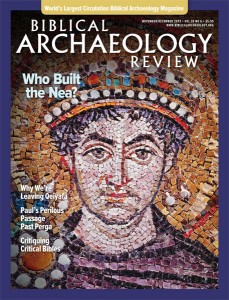Biblical Archaeology Review, November/December 2013
Features
The Emperor’s New Church on Main Street, Jerusalem
Longtime BAR readers are familiar with the sixth-century C.E. mosaic map of the Holy Land on the floor of a church in Madaba, Jordan. In the middle of the map lies Jerusalem, the center of the world. In the middle of the city is the Church of...Read more ›
An Ending and a Beginning
Why we’re leaving Qeiyafa and going to Lachish
The current heated debate on the relationship between history, the Bible and archaeology focuses on the tenth century B.C.E., the time of David and Solomon. In the early years of research, the Biblical narratives of David, Solomon and his son Rehoboam were considered an accurate historical account...Read more ›
Why Perga?
Paul’s perilous passage through Pisidia
“Then Paul and his companions set sail from Paphos [in Cyprus] and came to Perga in Pamphylia [in southern Anatolia] …They passed on from Perga and came to Antioch in Pisidia [in central Anatolia].” (Acts 13:13–14) Why Perga? Paul and Barnabas returned to Perga...Read more ›
What’s Critical About a Critical Edition of the Bible?
Although not widely known, all printed Hebrew Bibles in common use today contain textual difficulties, corruptions and—yes—even errors. Modern translations tend to smooth out difficulties in the original Hebrew. Occasionally some translations, such as the New Jewish Publication Society translation, tell the reader in a footnote that...Read more ›

